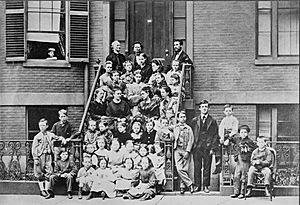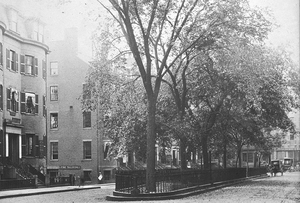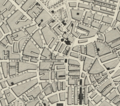Pemberton Square facts for kids
Pemberton Square is a historic area in Boston, Massachusetts. It was created in 1835 by Patrick Tracy Jackson. He designed it as a special neighborhood with buildings that all looked similar. These buildings were used for both homes and businesses, and they surrounded a small park.
In the mid-1800s, many people lived and worked there. Later, in 1885, a very large building called the John Adams Courthouse was built. This changed the look and feel of the square a lot. The Center Plaza building, built in the 1960s, also changed the area. Today, Pemberton Square is part of the Government Center area of Boston.
Contents
History of Pemberton Square
Early Development (1835–1885)
In the mid-1830s, a piece of land called Cotton Hill was developed. This land was located between Tremont Street and Somerset Street. Patrick Tracy Jackson bought this land after its previous owner, Gardiner Greene, passed away in 1832.
Jackson had a big idea: he wanted to create a nice place for people to live. To do this, he had the top of Cotton Hill cut down. This huge job took only five months and was finished in October 1835. The dirt from the hill was used to fill in a nearby water area, which later became the Bullfinch Triangle neighborhood.

Jackson held a contest to find the best design for his new property. Alexander Wadsworth, a local engineer, won the prize. In 1836, Jackson hired George Minot Dexter to design the houses for Pemberton Square. Dexter also designed all the metalwork, like stair railings and fences. The goal was for all the buildings to have a consistent and elegant style.
In 1838, the city officially named the area "Pemberton Square." For a short time, the area now known as Scollay Square was also called "Pemberton Square." But the city quickly changed its name to "Scollay Square" in June 1838. This was done to avoid confusion, as the two squares were very close to each other. Pemberton Square was set back a bit from Scollay Square, connected by a short street.
The homes built in Pemberton Square were very elegant for their time. For many years, important citizens lived there. Architects, lawyers, and other professionals also set up their offices in the square. Over time, more businesses and even city and state offices moved in. The headquarters for the police commissioners was one of them.
In the middle of the square was a green area with a few trees. This was a pleasant spot for people to relax. In 1848, during the city's Water Celebration, a parade passed through Pemberton Square.
Modern Changes (1885–present)
In 1885, Pemberton Square was chosen as the location for a new courthouse. The houses on the west side of the square were torn down that year to make room for the Suffolk County Courthouse. The central garden was also removed at that time. By 1895, some of the original curved-front houses remained, but they were being used as public and law offices.
Since the 1960s, Pemberton Square has become part of the larger Government Center area. This area has many large buildings. A few of the square's original homes on the east side lasted until 1969. Then, they were torn down along with two newer office buildings. In their place, a very long office building called Center Plaza was built.
The shape of Center Plaza follows the curve of the original houses on the east side of the square. However, the square itself, as it once was, no longer exists in the same way.
Notable Occupants
Many interesting people and organizations had homes or offices in Pemberton Square during the 1800s. Here are some of them:
- American Board of Commissioners for Foreign Missions
- American Colonization Society
- American Social Science Association
- Boston Conservatory of Elocution, Oratory, and Dramatic Art (which later became Emerson College)
- Boston Police Department
- Boston School for Deaf-Mutes (later known as the Horace Mann School for the Deaf and Hard of Hearing)
- Boston Society of Architects
- Boston University's "executive building, Jacob Sleeper Hall"
- Cummings and Sears, architects
- Forest Hills Cemetery office
- Gridley James Fox Bryant and Louis P. Rogers, architects
- Edward Clarke Cabot, architect
- George Barrell Emerson
- Lee & Follen, landscape architects (Francis L. Lee and Charles Follen)
- Massachusetts Society for the Prevention of Cruelty to Children
- Mount Auburn Cemetery office
- John Plumbe, a daguerreotypist (someone who made early photographs)
- Henry Vaughan (architect)
- Ware & Van Brunt, architects
Images for kids
-
Scollay Square, looking up to Pemberton Square, Boston, around the 1860s
-
The Center Plaza building at Pemberton Square, looking across Tremont St. from City Hall Plaza, 2005













